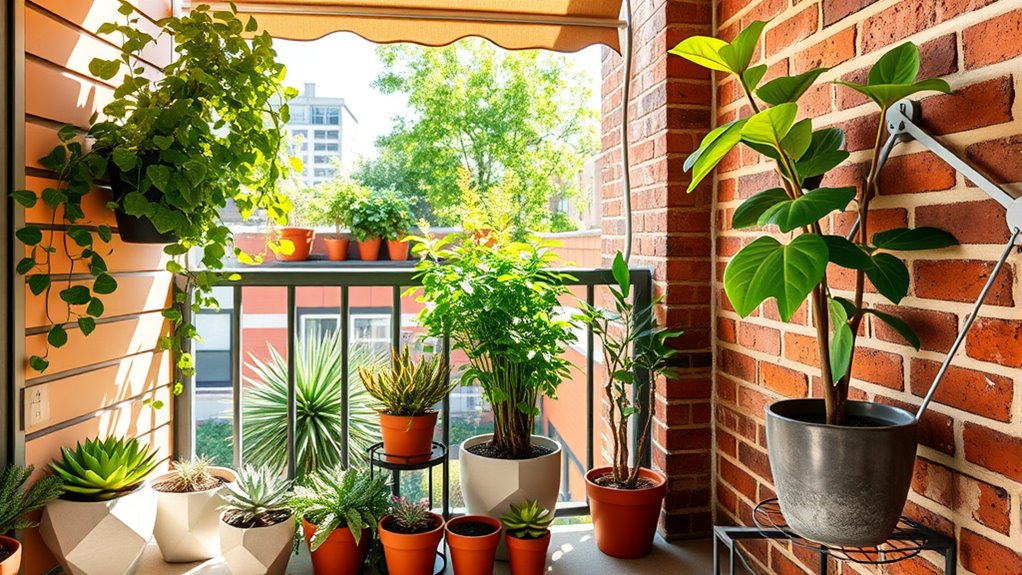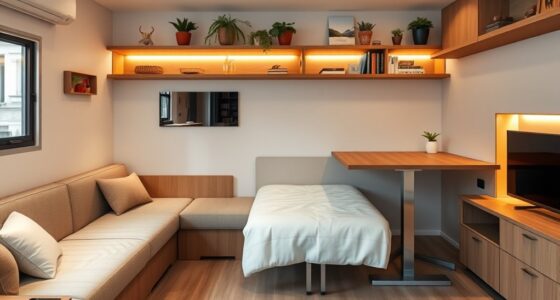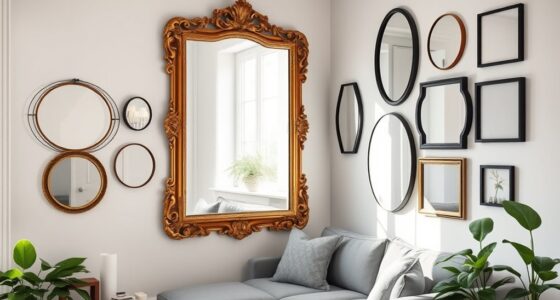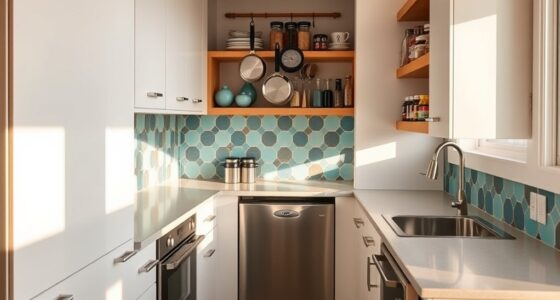In small spaces, focus on compact, low-maintenance plants like succulents, tiny violets, or miniature flowering varieties that thrive in containers and limited light. Use vertical arrangements such as wall-mounted planters or hanging baskets to maximize space and add visual interest. Place plants where they’re easy to care for and catch the right amount of light. If you want to explore creative placement tips and stylish design ideas, there’s plenty more to discover.
Key Takeaways
- Use compact, high adaptability plants like succulents and miniature flowering varieties for easy maintenance in small areas.
- Maximize space with vertical gardening, wall-mounted planters, and hanging baskets to add greenery without clutter.
- Place plants where they receive bright, indirect sunlight and ensure easy access for watering and care routines.
- Select containers that complement your decor and suit plant size, enhancing aesthetic appeal and functionality.
- Group plants by shape, color, and size to create visual interest and maintain a tidy, organized small space.

Living in a small space doesn’t mean you have to give up your love of plants. In fact, you can cultivate a lush, vibrant environment even in tight quarters by choosing the right varieties and thoughtful placement. Indoor succulents are perfect for tiny apartments or studio spaces because they require minimal soil, water, and space. Their compact size makes them ideal for desks, windowsills, or small shelves, adding a touch of greenery without overwhelming your space. You can create a mini succulent garden by grouping different shapes and colors together, which adds visual interest while keeping the area tidy and manageable. Additionally, selecting plants with high adaptability ensures they thrive in various indoor conditions and require less maintenance.
Similarly, compact flowering plants are excellent options for small spaces. Look for varieties known for their small stature, such as miniature azaleas, dwarf begonias, or tiny violets. These plants can thrive in containers on your balcony, windowsill, or even hanging baskets, giving you the joy of flowers without needing a sprawling garden. When placing these plants, consider their light and water needs. Position them where they’ll get the right amount of sunlight—bright but indirect light is usually best for most flowering plants. Avoid cluttering your space; instead, use vertical arrangements or tiered shelves to maximize every inch. This not only saves space but also creates a layered, dynamic look.
To make the most of your small space, think vertically. Wall-mounted planters or hanging baskets allow you to add greenery without sacrificing precious surface area. You can mount small indoor succulents or flowering plants on the wall, turning an empty wall into a living artwork. Using multi-tiered plant stands or stacking containers helps in creating depth and visual interest while keeping your floor space clear. Remember to choose containers that suit the plants’ needs and complement your decor. Small pots in neutral tones or metallic finishes can elevate the overall aesthetic.
When designing your plant layout, keep accessibility in mind. Place frequently watered or pruned plants at eye level or within easy reach, so caring for them remains simple. Also, consider the airflow and light distribution in your space to ensure your plants stay healthy. By thoughtfully selecting compact varieties and employing smart placement techniques, you transform even the smallest of spaces into a lively, inviting oasis. Your love for plants can flourish without taking over your entire apartment—just a little planning and some clever choices are all it takes.
Frequently Asked Questions
How Do I Prevent Pests in Small-Space Plantings?
To prevent pests in small-space plantings, you should practice natural pest control methods like introducing beneficial insects and using companion planting. Plant pest-repelling herbs such as basil or marigolds near your vegetables or other plants. Regularly inspect your plants for early signs of pests, remove affected leaves, and keep your space clean. These steps help deter pests effectively while maintaining a healthy, thriving garden in limited space.
What Are Low-Maintenance Plants Suitable for Limited Space?
You might think low-maintenance plants aren’t exciting, but compact succulents and trailing herbs prove otherwise. They’re perfect for limited space, needing minimal watering and care. Compact succulents thrive in small containers and add visual interest, while trailing herbs like thyme or oregano cascade beautifully in hanging planters. Both are resilient and perfect for busy lifestyles, giving you fresh greenery without the hassle. These plants make your small space vibrant and easy to manage.
Can I Grow Edible Plants in Small Balconies?
Absolutely, you can grow edible plants in small balconies by using vertical gardening and companion planting. Vertical gardens maximize limited space and make harvesting easier, while companion planting helps improve growth and deter pests. Choose compact vegetables like herbs, cherry tomatoes, or lettuce, and arrange them creatively in containers or wall-mounted planters. With some planning, your small balcony can become a productive, lush edible garden.
How Do I Ensure Proper Drainage in Compact Containers?
Ensuring proper drainage in compact containers is like giving your plants a breath of fresh air. You should add soil amendments like perlite or sand to improve drainage and choose container materials with drainage holes, such as terracotta or plastic. Avoid overfilling the container, and elevate it slightly with pot feet to prevent water from pooling at the bottom. This way, your plants stay healthy and thrive in small spaces.
What Lighting Options Are Best for Indoor Small-Space Gardens?
For your indoor small-space garden, grow lights are your best option, especially if natural sunlight is limited. Choose LED or fluorescent grow lights that provide full-spectrum light to mimic sunlight and support healthy plant growth. Position them close to your plants but not too close to avoid burning leaves. If possible, place your plants near windows to maximize natural sunlight, supplementing with grow lights when needed.
Conclusion
As you explore plants for small spaces, you’ll find that their versatility often surprises you—just like discovering a hidden garden in an unexpected corner. With thoughtful design and placement, your tiny oasis becomes a cozy retreat that feels larger and more vibrant. Sometimes, the perfect plant aligns exactly where you need it most, turning your small space into a lush, inviting sanctuary. It’s amazing how the right greenery can transform your world, one small step at a time.









